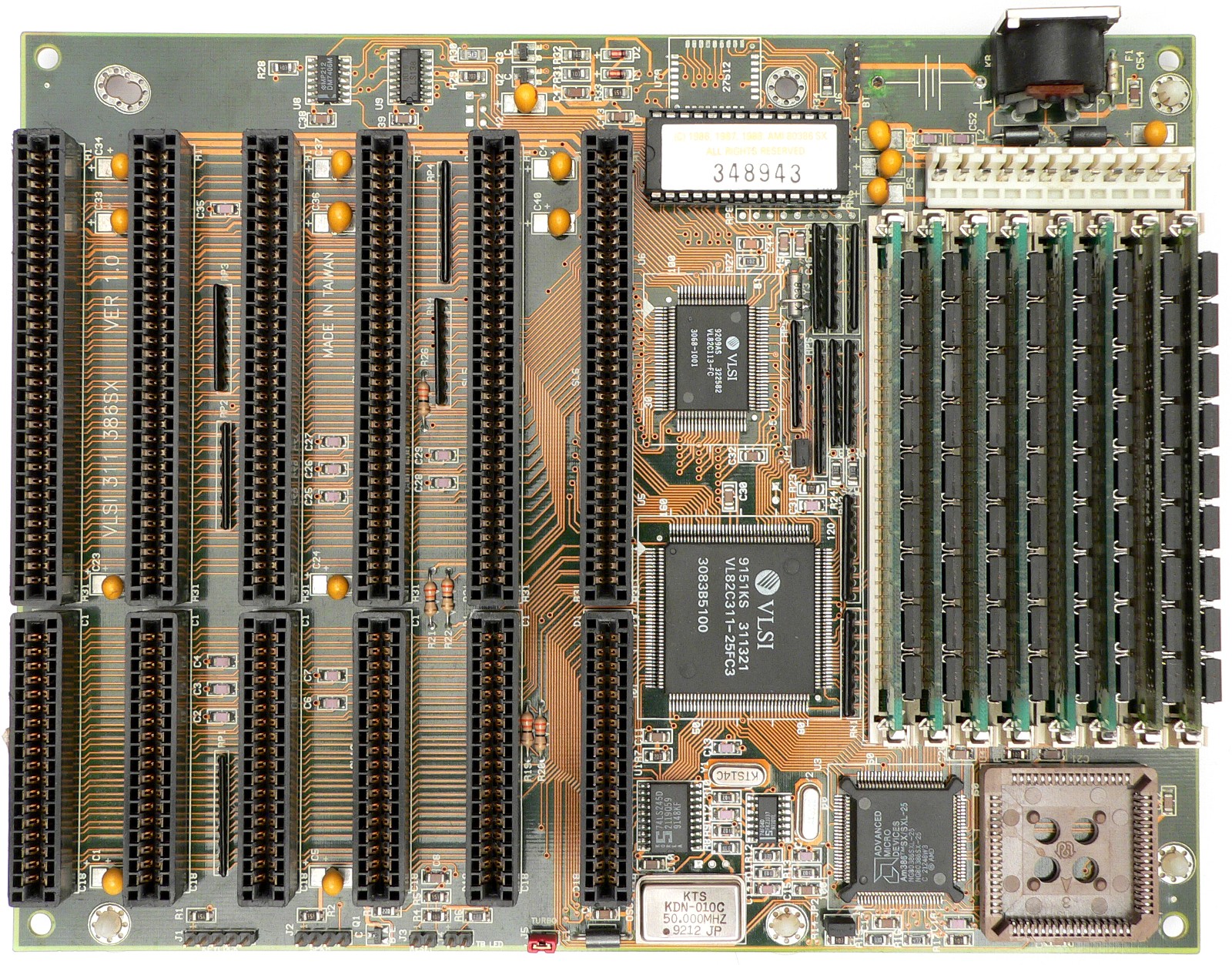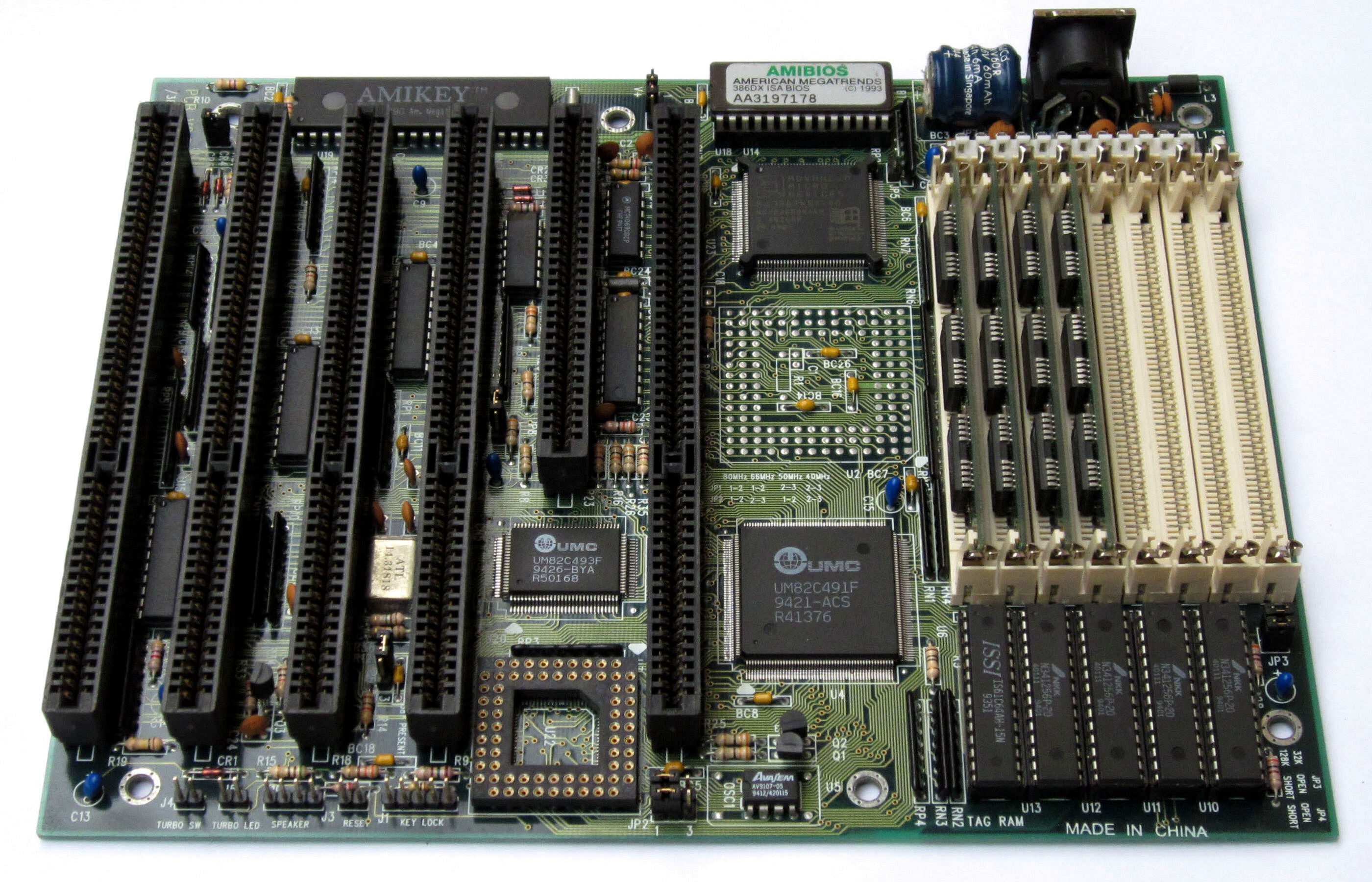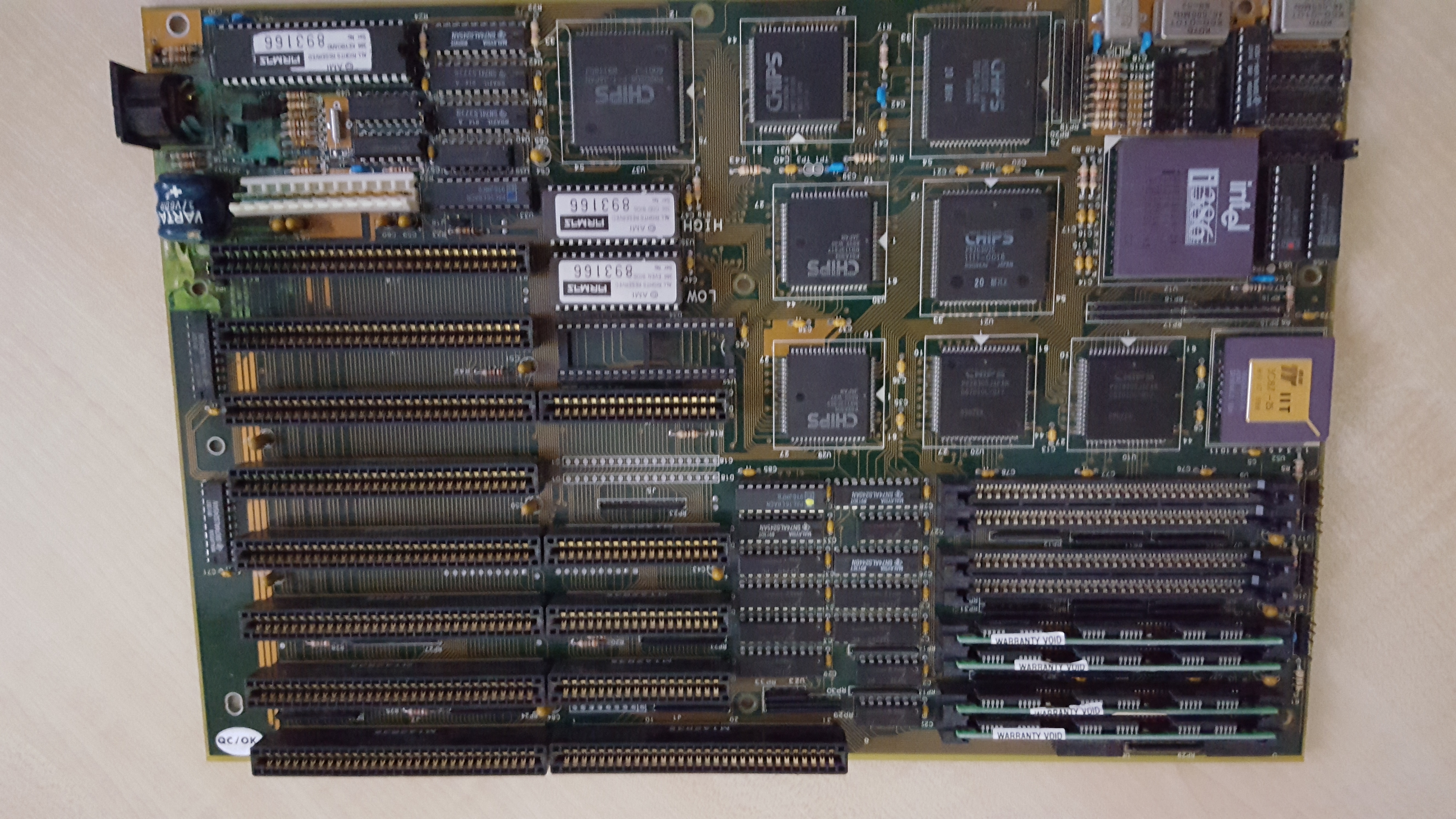80386 Motherboards
Most 80386-based motherboards were around before any standardisation of socketed CPUs came about. Some late 386-based boards are highly integrated with a single-chip controller (chipset), and a small number have VESA Local Bus (often abbreviated to VLB) slots though these are quite rare - VLB was in its infancy at the time, and some boards even pre-date the VLB specification, so compatibility may be patchy - those that do support VLB often have a 486 socket which gives some indication as to the timeframe when these were designed - these are sometimes referred to as 386/486 hybrid boards.
Onboard caches started to appear during the 80386's later heyday years, where boards could be seen with anywhere from 64 KB up to 256 KB or even 512 KB of cache chips.
During the 80386 era, most motherboards weren't heavily branded (it didn't matter as much which chipset it had, or who the manufacturer was) - generally, design and quality were very good.
VLSI 311 386SX v1.0
 A modern Baby AT form factor motherboard, this one with a VLSI 82C311 chipset and AMD Am386SX-25 CPU.
A modern Baby AT form factor motherboard, this one with a VLSI 82C311 chipset and AMD Am386SX-25 CPU.
This is about as compact a motherboard as you'll find in this era with a 386 on it, but still manages to squeeze six 16-bit ISA expansion slots onto it, as well as 4 banks of 30-pin SIMM slots (since it's a 386SX motherboard with a 16-bit data bus width, each bank requires two 8-bit SIMMs). Maximum memory supported is 16 MB, far more than would be typical of a 386 when 2 to 4 MB were a lot more the norm.
Assumed to be a budget to mid-range board, given the soldered-in 386SX. Still, A tidy-looking late-386 board.
Unknown Baby AT Am386 Board
 This is a late 386 motherboard, given its Baby AT form factor and embedded PQFP-packaged Am386DX-40 CPU. It appears to use the UMC 82C491 / 82C493 chipset.
This is a late 386 motherboard, given its Baby AT form factor and embedded PQFP-packaged Am386DX-40 CPU. It appears to use the UMC 82C491 / 82C493 chipset.
It has five 16-bit ISA slots and a single 8-bit slot. It supports 2 banks of 30-pin SIMM memory.
You can see in the lower-right corner the onboard 256 KB cache, which is the highest you see on a 386 board.
Unknown C&T 80386 Board
 I did a full review of this 386 motherboard, so if you want all the details, head on over to my review here.
I did a full review of this 386 motherboard, so if you want all the details, head on over to my review here.
In summary though, this has a Chips & Technologies 386 chipset which is one of the first to allow software/firmware tweaking without a multitude of jumpers on the board itself.
The picture to the right shows signs of corrosion from a leaking CMOS backup battery - rest assured this has been cleaned up.
I don't have the manual for this board, but a similar board is the ECS 386/32.
EliteGroup (ECS) FA386 Board
This board has a UMC chipset consisting of the UM82C481BF and UM82C482AF controller chips. It supports faster 386DX CPUs including the Cyrix 486DLC-40 and AMD Am386DX-40.
The BIOS supports the Cyrix chip's L1 cache natively, so no need to run the special Cyrix utilities after boot-up to enable it.
ALI386/486DLC Board
 This late 386 motherboard supports the Cyrix 486DLC or Texas Instruments Ti486DLC chip, which is 80386 pin-compatible but includes all 486 instructions as well.
This late 386 motherboard supports the Cyrix 486DLC or Texas Instruments Ti486DLC chip, which is 80386 pin-compatible but includes all 486 instructions as well.
Based around the popular ALi M1429/M1431 chipset, the board has an embedded AMD Am386DX-40 CPU which is the fastest native 386 CPU ever made. Variants can be seen with or without a PGA socket (missing on the version seen in the main image here).
Also onboard is a fairly typical 128 KB of cache and an Award BIOS. There are 8 memory slots which are of the 30-pin SIMM variety, broken up into 2 banks. The maximum memory supported is 128 MB.
More images of this board: 1 2 3 4
Another ALI386/486DLC board: 1 2 3 4
Chicony CH-386-33H/40H Board
This board has a UMC chipset consisting of the UM82C481A and UM82C482AF controller chips.
The BIOS supports the Cyrix chip's L1 cache natively, so no need to run the special Cyrix utilities on boot-up to enable it.
Octek Panther II 386SX Board
This board has an OPTi chipset. It comes with an AMD-branded 386SX processor ranging from 16 MHz up to 33 MHz, and a socket for the 80387 math coprocessor. Memory is added via 4 30-pin SIMM slots capable of accepting a maximum of 16 MB of DRAM. Interleaving is supported for all pages of memory to ensure the fastest access possible. A very compact board for the 386-era, it still manages four 16-bit ISA expansion slots and two 8-bit ISA slots.
Head over to the dedicated Octek page for more details.
Pine Technology PT-308 Board
 This is a late 386SX motherboard by Pine Technology in a compact Baby AT form factor with 7 ISA expansion slots.
This is a late 386SX motherboard by Pine Technology in a compact Baby AT form factor with 7 ISA expansion slots.
It has a PQFP soldered-in Intel 80386SX-25 CPU. The AMI BIOS chip looks like it has been replaced. Chipset-wise, this uses the VLSI 82C311 SCAMP chipset.
Memory support is via 4 banks of 30-pin SIMMs.
More pics of this board: 1 2 3
Another revision of this board got green silk screening instead of brown.
Pine Technology PT-319A Board
 This is a late 386SX motherboard by Pine Technology - the AMI BIOS chip is dated 1992.
This is a late 386SX motherboard by Pine Technology - the AMI BIOS chip is dated 1992.
It has a PQFP soldered-in AMD Am386SX-40 CPU. One of the jumpers on the board defines whether a 386SX or a Cyrix Cyrix 486SLC is installed. I guess Pine would fit both types based on stock and subtle circuit changes on the board were needed for the Cyrix.
More pics of this board: 1 2 3 4
It appears to use a SARC Cyclone RC2016A4 as the single-chip controller.
It has six 16-bit ISA slots, and supports 2 banks of 30-pin SIMM memory (386SX boards have a 16-bit external data bus - 30-pin SIMMs are 8-bit, so two are needed for the full width). Maximum onboard RAM is 16 MB.
Another version of this same board uses a SARC Cyclone RC2016A5 single-chip controller. Here's a second pic.